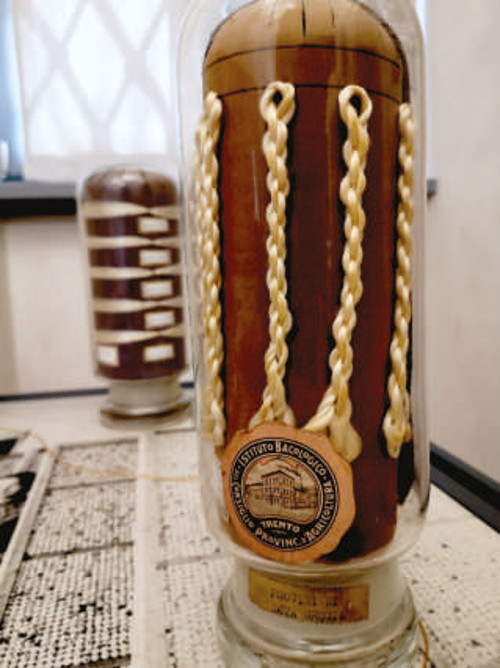Display board 1
ONCE UPON A TIME THERE WAS A SILKEN THREAD. THE "WALKING BOOK"
Long gone are the times described by the French philosopher Montesquieu when the inhabitants of Rovereto were all employed in the manufacture of silk in its initial stages. The birth, development and decline of the silk industry constituted however one of the most important chapters in the town's history. From the C16th to the C19th this phenomenon dominated Rovereto's urban development and profoundly influenced the economy of the area and the life of its inhabitants.
The walking book "Rovereto City of Silk" offers an open-air itinerary approximately 1,300 metres in length, winding among millraces and silk-spinning mills in the old quarter of Santa Maria and along the banks of the river Leno. The 10 panels showing the various stages of the process illustrate the changing fortunes of the silk industry from historical, architectural, economic, technological and socio-cultural points of view. Further studies and numerous objects are on display in the new seat of the town museum in Palazzo Sichart, via Calcinari.
The walking book produced by the Rovereto Civic Museum Foundation with a contribution from the Town Council of Rovereto seeks to safeguard and highlight the patrimony of industrial archaeology still visible in the historic centre of the town.
The conservation and study of these testimonies are in fact fundamental for understanding the Rovereto of today and for enabling new generations to comprehend the history and identity of the area.
SILK FROM CHINA TO ITALY
The origin of silk worm farming is extremely old and lost in legend. One of Confucius' books relates that in about 2,600 B.C. a Chinese Empress taught her people how to breed silk worms and extract the silk from the cocoons. For this gift to her subjects the Empress was deified and adored as the silk goddess.
The Chinese jealously kept the art of silk-making secret and severely punished anyone who tried to export it to other countries. It is said that at the beginning of the first century A.D. a Chinese princess who married the King of Kothan, so as not to lose her luxurious garments, smuggled the silk worm eggs from her country in her hair. The manufacture of this precious cloth thus spread to India and Japan.
Through the trade routes between the Orient and Europe commonly known as the "Silk Road" Chinese fabrics reached as far as Rome where, in the first centuries of the Christian era, their price equalled that of gold. The Greeks and Romans however used the silk without knowing its origins, thinking it came from vegetal fibre.
Sericulture in the West began in the Byzantine era when two monks returning from a journey to India and China in 551 A.D, carried the silk worm eggs to Constantinople hidden in their staves and presented them to the Emperor Justinian.
The Arabs also contributed to the spread of the silk-making art throughout the Mediterranean, introducing it to Spain in the 9th century.
However one of the first places to begin manufacturing silk was Sicily. In 1147 the Norman King Ruggero had some craftsmen skilled in this art brought as prisoners from Thebes to Palermo: thanks to them he founded a flourishing manufacturing industry. Thus the great Italian art of silk-making was born and maintained its European primacy for centuries.
